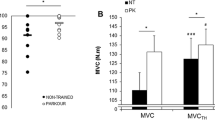Abstract
This study is based on the analysis of electrophysiological characteristics describing the neuromuscular system of athletes during their training sessions, depending on their specialization and level of sport skills. It has been shown that the physiological changes securing the perfection of strength training in weightlifting athletes are mainly concentrated in the peripheral part of their neuromuscular system, namely, at the level of muscles themselves and neuromuscular junctions, and reflected in the electromyogram characteristics as arbitrary movements and M response parameters. At the same time, physiological rearrangements in combat athletes touch the peripheral mechanisms and the central component in the regulation of motor activity and are reflected in the parameters of visual and somatosensory evoked brain potentials. The results disclose an entire set of new important approaches to the functioning of different compartments in the nervous system and the neuromuscular apparatus in athletes of different specializations. They can serve as the basis for the development of practical recommendations on the organization of sports-specialized selection at different stages of athletic perfection, as well as for the physiological support of training process and methods of operating control.
Similar content being viewed by others
References
Zverev, V.D., Dal’skii, D.D., and Naumenko, E.V., Operational control of the functional state of powerlifters, Uch. Zap. Univ. im. P.F. Lesgafta, 2012, vol. 87, no. 5, p. 42.
Hedayatpour, N. and Falla, D., Non-uniform muscle adaptations to eccentric exercise and the implications for training and sport, J. Electromyogr. Kinesiol., 2012, vol. 22, no. 3, p. 329.
Fudin, N.A., Vagin, Yu.E., and Pigareva, S.N., System fatigue mechanisms at exercises of circular orientation, Vestn. Nov. Med. Tekhnol., 2014, vol. 21, no. 3, p. 118.
Fudin, N.A., Klassina, S.Ya., and Pigareva, S.N., Analysis of relationships of electromyorgam and electrocardiogram indicators in people doing graded physical exercise and sports, Sportivnaya Med.: Nauka Prakt., 2014, no. 2, p. 25.
Bernshtein, N.A., Fiziologiya dvizhenii i aktivnost’ (Physiology of Movement and Action), Moscow: Nauka, 1990.
Tarasova, O.S., Borovik, A.S., Kuznetsov, S.Yu., et al., The pattern of changes in physiological parameters in the course of changes in physical exercise intensity, Hum. Physiol., 2013, vol. 39, no. 2, p. 171.
Mart’yanov, V.A., Funktsional state of the central nervous system, in Sportivnaya bor’ba: Ezhegodnik (Wrestling: Yearbook), Moscow, 1986, p. 14.
Shakhanova, A.V., Koblev, Ya.K., Petrova, T.G., and Namitokova, A.A., Specific features of the functional condition of the central nervous system in judoists, Vestn. Adygeiskogo Gos. Univ. Ser. 4: Estestv.-Mat. Tekh. Nauki, 2010, no. 3, p. 49.
Behmer, L.P. and Fournier, L.R., Working memory modulates neural efficiency over motor components during a novel action planning task: an EEG study, Behav. Brain Res., 2014, vol. 260, p. 1.
Papin, M.A. and Stepanov, V.Yu., Individual characteristics of the state of the neuromuscular apparatus in boxers of different qualification during the preparatory period, Fiz. Kul’t. Sport Verkhnevolzh’ya, 2013, no. 6, p. 72.
Zhang, J., Chen, R., Wu, Y., et al., An EMG study on characteristics of premotor and motor components in an agility reaction time test on athletes, J. Sports Med. Phys. Fitness, 2013, vol. 53, no. 5, p. 566.
Gurfinkel, V.S. and Levik, Yu.S., A system of internal representation and motor control, Vestn. Ross. Akad. Nauk, 1995, vol. 65, no. 1, p. 29.
Bocharov, M.I., Chastnaya Biomekhanika s fiziologiei dvizheniya (Particular Biomechanics with Motor Physiology), Ukhta: Ukhtinskii Gos. Tekh. Univ., 2010.
Golovanov, S.A., Anokhina, N.D., and Rasulov, M.M., Correction of the muscle activity in men during power loading, Teor. Prakt. Fiz. Kul’t., 2010, no. 8, p. 66.
Simão, R. and Spineti, J., Influence of exercise order on maximum strength and muscle thickness in untrained men, J. Sports Sci. Med., 2010, no. 1(9), p. 1.
Kolpakov, V.V., Bespalova, T.V., Tomilova, E.A., et al., Functional reserves and adaptive capacity of subjects with different levels of habitual physical activity, Hum. Physiol., 2011, vol. 37, no. 1, p. 93.
Pfusterschmied, J., Stöeggl, T., Buchecker, M., et al., Effects of 4-week slackline training on lower limb joint motion and muscle activation, J. Sci. Med. Sport, 2013, vol. 16, no. 6, p. 562.
Silva, L., Marta, S., Vaz, J., et al., Trunk muscle activation during golf swing: baseline and threshold, J. Electromyogr. Kinesiol., 2013, vol. 23, no. 5, p. 1174.
Karg, M., Venture, G., Hoey, J., et al., Human movement analysis as a measure for fatigue: A hidden Markov- based approach, IEEE Trans. Neural Syst. Rehabil. Eng., 2014, vol. 22, no. 3, p. 470.
Ring, C., Cooke, A., Kavussanu, M., et al., Investigating the efficacy of neurofeedback training for expediting expertise and excellence in sports, Psychol. Sport Exercise, 2015, vol. 16, no. 1, p. 118.
Milligan, A., Mills, C., and Scurr, J., The effect of breast support on upper body muscle activity during 5 km treadmill running, Hum. Mov. Sci., 2014, vol. 38, p. 74.
Greig, M. and Marchant, D., Speed dependant influence of attentional focusing instructions on force production and muscular activity during isokinetic elbow flexions, Hum. Mov. Sci., 2014, vol. 33, p. 135.
Balasubramanian, V., Jagannath, M., and Adalarasu, K., Muscle fatigue based evaluation of bicycle design, Appl. Ergon., 2014, vol. 45, no. 2, p. 339.
Fleming, N., Donne, B., and Mahony, N., A comparison of electromyography and stroke kinematics during ergometer and on-water rowing, J. Sports Sci., 2014, vol. 32, no. 12, p. 1127.
Bredikhina, Yu.P., Guzhov, F.I., Andreev, V.I., et al., Evaluation of athletes’ coordination abilities in karate, Teor. Prakt. Fiz. Kul’t., 2010, no. 11, p. 6.
Kapilevich, L.V., Physiological mechanisms of movement coordination in the unsupported position in athletes, Teor. Prakt. Fiz. Kul’t., 2012, no. 7, p. 45.
Blake, O.M., Champoux, Y., and Wakeling, J.M., Muscle coordination patterns for efficient cycling, Med. Sci. Sports Exercise, 2012, vol. 44, no. 5, p. 926.
Fudin, N.A., Klassina, S.Ya., and Pigareva, S.N., Features of the systemic organization of physiological functions in different stages of increasing physical activity in persons doing increasing intensity graded physical exercises and sports, Sport. Med.: Nauka Prakt., 2014, no. 3, p. 14.
Kazantsev, S.A. and Val’kovskii, V.A., Experience of studying the professionally important qualities of various sports based on the properties of the nervous system of athletes, Uch. Zap. Univ. im. P.F. Lesgafta, 2015, no. 1(119), p. 214.
Gnezditskii, V.V. and Korepina, O.S., Atlas po vyzvannym potentsialam mozga (Atlas of Evoked Potentials of the Brain), Ivanovo: PreSto, 2011.
Author information
Authors and Affiliations
Corresponding author
Additional information
Original Russian Text © L.V. Kapilevich, M.B. Lojkina, S.G. Krivoschekov, 2016, published in Fiziologiya Cheloveka, 2016, Vol. 42, No. 4, pp. 51–60.
Rights and permissions
About this article
Cite this article
Kapilevich, L.V., Lojkina, M.B. & Krivoschekov, S.G. Electrophysiological neuromuscular systemic characteristics of athletes in power training. Hum Physiol 42, 392–400 (2016). https://doi.org/10.1134/S0362119716030099
Received:
Published:
Issue Date:
DOI: https://doi.org/10.1134/S0362119716030099




